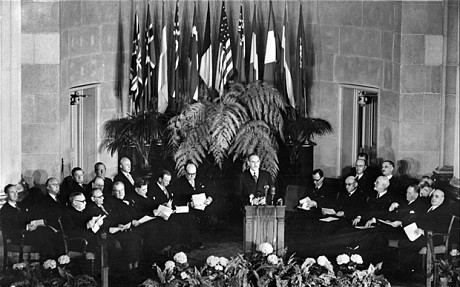
From Office of the Historian, U.S. Department of State: In this agreement, the United States, Canada, Belgium, Denmark, France, Iceland, Italy, Luxemburg, the Netherlands, Norway, Portugal, and the United Kingdom agreed to consider attack against one an attack against all, along with consultations about threats and defense matters. This collective defense arrangement only formally applied to attacks against the signatories that occurred in Europe or North America; it did not include conflicts in colonial territories. After the treaty was signed, a number of the signatories made requests to the United States for military aid. Later in 1949, President Truman proposed a military assistance program, and the Mutual Defense Assistance Program passed the U.S. Congress in October, appropriating some $1.4 billion dollars for the purpose of building Western European defenses.
Soon after the creation of the North Atlantic Treaty Organization, the outbreak of the Korean War led the members to move quickly to integrate and coordinate their defense forces through a centralized headquarters. The North Korean attack on South Korea was widely viewed at the time to be an example of communist aggression directed by Moscow, so the United States bolstered its troop commitments to Europe to provide assurances against Soviet aggression on the European continent. In 1952, the members agreed to admit Greece and Turkey to NATO and added the Federal Republic of Germany in 1955. West German entry led the Soviet Union to retaliate with its own regional alliance, which took the form of the Warsaw Treaty Organization and included the Soviet satellite states of Eastern Europe as members.
The collective defense arrangements in NATO served to place the whole of Western Europe under the American "nuclear umbrella." In the 1950s, one of the first military doctrines of NATO emerged in the form of "massive retaliation," or the idea that if any member was attacked, the United States would respond with a large-scale nuclear attack. The threat of this form of response was meant to serve as a deterrent against Soviet aggression on the continent. Although formed in response to the exigencies of the developing Cold War, NATO has lasted beyond the end of that conflict, with membership even expanding to include some former Soviet states. It remains the largest peacetime military alliance in the world. (photo: EPA)
Image: epa%204%204%2013%20Washington%20Treaty.jpg
